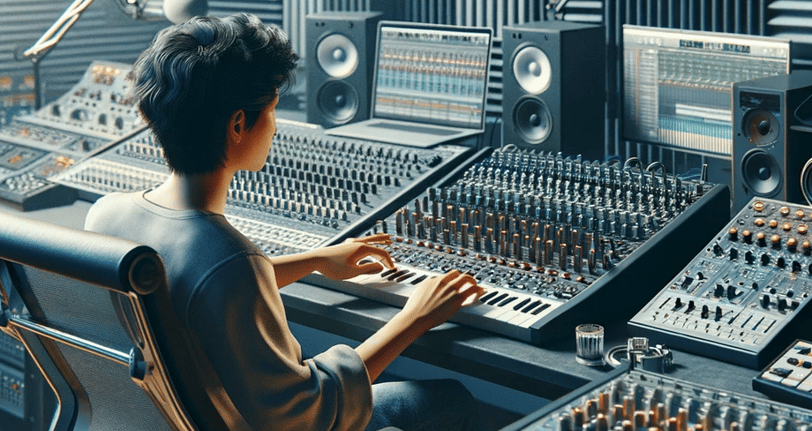The Science of Sound Design: Crafting Sonic Masterpieces from Scratch
In the vast realm of audio production, the art of sound design stands as a mesmerizing intersection of creativity and science.
1/4/20243 min read


In the vast realm of audio production, the art of sound design stands as a mesmerizing intersection of creativity and science. It is the process of meticulously crafting and manipulating sounds to evoke emotions, enhance storytelling, and create immersive experiences. In this exploration of the science of sound design, we delve into the principles behind shaping audio landscapes and conjuring captivating sounds from the ground up.
The Anatomy of Sound:
Sound is a complex phenomenon, and understanding its basic components is fundamental to sound design. At its core, sound consists of waves—oscillations of air molecules that our ears interpret. Explore the concepts of frequency, amplitude, and timbre, which form the building blocks of any sound. Frequency determines pitch, amplitude relates to volume, and timbre gives each sound its unique character.
Tools of the Trade: Software and Hardware:
Sound designers wield an array of tools to shape their sonic visions. From software synthesizers to hardware samplers, the arsenal of a sound designer is diverse. Discuss popular software like Ableton Live, Logic Pro, and synthesizers like Serum or Massive. Explore the tactile nature of hardware synthesizers and the intuitive control they offer over sound parameters, emphasizing the symbiotic relationship between the artist and their tools.
The Power of Synthesis:
Synthesis is the heart of sound design, offering the ability to generate sounds from scratch. Delve into the different types of synthesis—subtractive, additive, FM (Frequency Modulation), and wavetable synthesis. Each technique has its unique approach to sculpting sound, providing sound designers with endless possibilities for creating textures, atmospheres, and dynamic elements.
Subtractive Synthesis: Involves starting with a complex sound and shaping it by removing frequencies using filters.
Additive Synthesis: Builds sounds from the ground up by layering individual sine waves to create complex timbres.
FM Synthesis: Modulates the frequency of one waveform with another, resulting in intricate and evolving sounds.
Wavetable Synthesis: Utilizes pre-recorded waveforms to create evolving and morphing sonic textures.
Sampling: The Art of Borrowing and Transforming:
Sampling is another cornerstone of sound design, involving the manipulation of pre-existing sounds to create something entirely new. Explore the ethics and creativity behind sampling, and how it has been a driving force in the evolution of various music genres. Discuss the use of field recordings, vocal snippets, and unconventional sources to infuse a unique character into compositions.
Spatial Awareness: The 3D Canvas of Sound:
Sound is not just about what we hear; it's also about where we hear it. Dive into the realm of spatial sound design, exploring techniques like panning, stereo imaging, and the use of reverb and delay to create depth and dimension in audio compositions. Discuss the role of binaural audio in providing a truly immersive experience, mimicking the way our ears perceive sound in the real world.
Emotion and Narrative: Crafting Soundscapes:
Sound design is a narrative tool, capable of eliciting emotions and enhancing storytelling. Explore how sound designers use sonic elements to create tension, suspense, and resolution in films, video games, and other media. Discuss the concept of sonic branding and how specific sounds become synonymous with certain emotions or actions.
Collaboration and Cross-Disciplinary Creativity:
Sound design often involves collaboration with other creative disciplines. Explore how sound designers work with filmmakers, game developers, and other artists to achieve a cohesive and immersive experience. Discuss the importance of communication in translating the vision of a project into sound, and how cross-disciplinary collaboration can lead to groundbreaking innovations in audio production.
The Future of Sound Design: Technological Frontiers:
As technology advances, so does the landscape of sound design. Explore emerging technologies such as spatial audio, artificial intelligence, and interactive soundscapes that push the boundaries of what is possible in the realm of audio production. Discuss how these innovations are shaping the future of sound design and opening up new avenues for creative expression.
Conclusion:
In the intricate dance between creativity and science, sound design emerges as a profound art form, capable of shaping our perceptions and transporting us to alternate realities. By understanding the principles of sound, harnessing the power of synthesis and sampling, exploring spatial dimensions, and collaborating across disciplines, sound designers create sonic masterpieces that transcend the boundaries of imagination. As we continue to push the technological frontiers of audio production, the science of sound design remains a dynamic and evolving journey into the heart of auditory creativity.
